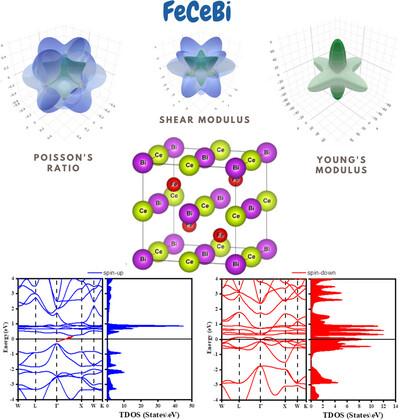First‐Principles Study of the Spintronic Potential of the Rare‐Earth‐Based Half‐Heusler Compound FeCeBi
IF 2.9
4区 工程技术
Q1 MULTIDISCIPLINARY SCIENCES
引用次数: 0
Abstract
Systematic theoretical research of the half‐Heusler compound FeCeBi is carried out using first‐principles calculations on density functional theory (DFT) here. Three candidate crystal structures are studied, of which it is found that the ground‐state most stable configuration is the α‐phase in the ferromagnetic (FM) state. Electronic band structure computations verify that FeCeBi is an ideal half‐metal with a semiconducting gap in the spin‐up channel and metallic behavior in the spin‐down channel, and hence, it is highly promising for spintronic devices. Elastic properties such as elastic constants (C

稀土基半Heusler化合物FeCeBi自旋电子势的第一性原理研究
本文利用密度泛函理论(DFT)的第一性原理计算对半Heusler化合物FeCeBi进行了系统的理论研究。研究了三种候选晶体结构,发现基态最稳定的构型是铁磁态的α相。电子能带结构计算证实了FeCeBi是一种理想的半金属,在自旋向上通道中具有半导体间隙,在自旋向下通道中具有金属行为,因此,它在自旋电子器件中具有很高的应用前景。弹性特性,如弹性常数(C11, C12和C44),根据Born-Huang准则确认了机械稳定性。其他力学指标,如B/G比和泊松比,表明延性和刚度的良好平衡。此外,电子结构被确定为结构变形敏感;当压缩时,带隙扩大,而带隙随膨胀而减小。这种可调性使得FeCeBi很容易适应特定的应用程序。光学研究揭示了自旋依赖效应,进一步证实了该化合物的非对称半金属性质。总的来说,结果表明FeCeBi是未来自旋电子和多功能器件技术的非常合适的候选材料。
本文章由计算机程序翻译,如有差异,请以英文原文为准。
求助全文
约1分钟内获得全文
求助全文
来源期刊

Advanced Theory and Simulations
Multidisciplinary-Multidisciplinary
CiteScore
5.50
自引率
3.00%
发文量
221
期刊介绍:
Advanced Theory and Simulations is an interdisciplinary, international, English-language journal that publishes high-quality scientific results focusing on the development and application of theoretical methods, modeling and simulation approaches in all natural science and medicine areas, including:
materials, chemistry, condensed matter physics
engineering, energy
life science, biology, medicine
atmospheric/environmental science, climate science
planetary science, astronomy, cosmology
method development, numerical methods, statistics
 求助内容:
求助内容: 应助结果提醒方式:
应助结果提醒方式:


